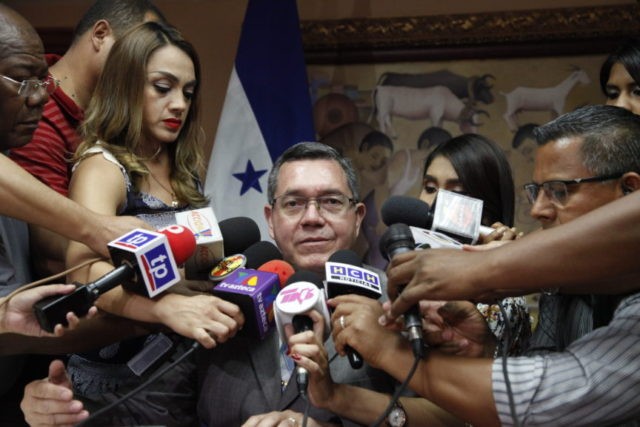NEW YORK (AP) — The Trump administration said Friday that it is ending special immigration protections for about 57,000 Hondurans, adding them to hundreds of thousands of immigrants from other countries battered by violence and natural disasters who are losing permission to be in the United States.
The U.S. Department of Homeland Security’s widely anticipated decision not to renew temporary protected status for Hondurans means an estimated 428,000 people from several countries face rolling deadlines beginning late this year to leave or obtain legal residency in other ways.
Hondurans will have until Jan. 5, 2020, Homeland Security Secretary Kirstjen Nielsen said.
President Donald Trump — who wants to curtail legal immigration and has been cracking down broadly on illegal immigration — and his supporters note that the protections were never meant to be permanent.
Immigrant advocates decried the move and contend that ending the status will drive people underground who have been establishing roots in the U.S. for years or decades, including having American-born children.
For Hondurans, the program known as TPS has been in place since 1999 after Hurricane Mitch devastated in the Central American nation the year before.
The administration says conditions in Honduras have improved, while advocates argue that it still hasn’t fully recovered from the hurricane and is now plagued by rampant violence.
Trump, his opponents argue, is effectively adding tens, if not hundreds, of thousands of people to the ranks of those in the U.S. without legal status.
Marta Connor, a 50-year-old union organizer in Southern California who has lived in the U.S. for decades and has three American-born children, said before the announcement that she wasn’t leaving, regardless of the administration’s policies.
“One thing I can tell you is I am not going to Honduras,” she said, noting that many of the asylum-seeking migrants in a caravan that recently reached the U.S.-Mexico border are from Honduras. “If they are coming, why am I going over there?”
“There is no way I will go back,” Connor said.
Around 437,000 immigrants hailing from 10 countries have had temporary protected status, a designation created in 1990 to allow people from countries affected by natural disasters like earthquakes or man-made disasters like war to have a short-term safe haven. Only a few thousand still have that status.
Those with it have generally been able to work and with permission, travel outside the U.S. and return.
Countries are added to the list as circumstances warrant, with renewals coming usually around every 18 months. While some countries have been taken off the list, others have stayed on it for extended periods, which critics say turns the program into default amnesty.
Under Trump, the Department of Homeland Security has terminated the program for Sudan, Nicaragua, Nepal, Haiti, and notably El Salvador, which accounted for more holders of the special status than any other nation.
They have been given deadlines to leave or gain legal status if possible, starting in November for Sudan and throughout 2019 for the other countries. Several groups are suing to stay in the U.S.
The protections have been extended for 6,900 Syrians who already have them, but the administration has said it won’t take on new applicants. Decisions are upcoming for South Sudan, Somalia and Yemen, which cover fewer than 1,700 people.
Daniel Sharp, legal director at the Central American Resource Center in Los Angeles, said he doesn’t believe most immigrants with the status will leave after setting down roots with U.S.-born children, jobs and homes.
“People don’t want to go back to being undocumented, but I don’t think you are going to see a ton of people returning to their countries of origin,” he said.
El Salvador actually had the protections twice, the first time in the early 1990s until December 1994. It’s estimated that about 150,000 people were covered then.
Cecilia Menjivar, a University of Kansas sociology professor, said that while exact numbers are unknown, it’s clear many stayed in the U.S. when the program ended. Some got permanent residency through family sponsorship, but immigration law has changed since then that “there are fewer avenues for legalization,” she said.
Ramba Regmi, 53, a native of Nepal who’s been in New York City for close to two decades, doesn’t know what she’s going to do. She spent many of those years without legal status after overstaying a visa but got protections after an April 2015 earthquake in Nepal killed more than 8,000 people.
With the legal authorization the program provides, she was able to go from working in a nail salon to owning one, where she employs three people. She financially supports her husband and adult children in Nepal, which she says still hasn’t recovered from the earthquake.
“I never thought this was going to end, so what can I say?” Regmi said after the government declined last week to renew protections for about 9,000 Nepalis. “This is very difficult.”
___
Taxin reported from Santa Ana, California. Hajela and Taxin cover immigration issues for The Associated Press. Follow them on Twitter at http://www.twitter.com/dhajela and https://twitter.com/ataxin . For more of their work, search for their names at https://apnews.com .

COMMENTS
Please let us know if you're having issues with commenting.